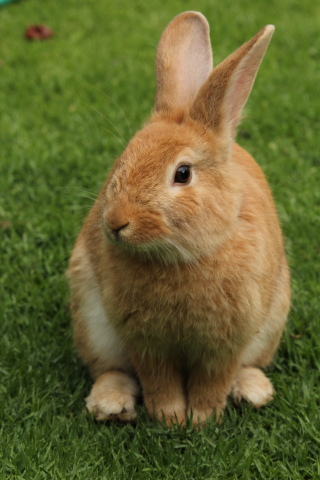Serval: Trochu kočka, trochu pes
Tato africká kočkovitá šelma má na kočku dosti netypickou stavbu těla. Díky svým dlouhým nohám vypadá spíše jako pes. A ač jde o zvíře divoké, často hraje i roli domácího mazlíčka.
Not only dogs and cats communicate with us non-verbally. Even rabbits tell us what and how they feel with their non-verbal expressions such as postures, gestures and sounds. It helps us understand what mood they are just in. Let’s look at expression which are the most typical ones for these little friends.


Sniffing
As well as other animals, also rabbits rely on their own noses for recognizing well-known people and strangers. However, when the sniffing turns to poking with its nose, your little furry friend wants attention and wants you to caress it and spend time with it.
Stretching
Not many people know that rabbits can stretch the same way cats do. They basically do the same thing with their back. They stand on all four paws and make a subtle noise. Rabbits stretch like this mainly after they wake up or stop relaxing. It looks really cute.
Licking
Rabbits express their affection by this. If they lick you, you know you are one of the people they like and they want to express their gratitude for being good to them. If a rabbit licks you, you may cuddle or caress it. You will show you like it as well by it.
Territory marking
Rabbits mainly use their poop, urine and glands under their chin to mark their territory. These furry friends usually mark their territory by wiping its chin on the things it considers or wants to consider its own. Every rabbit, may it be male or female, has to have a clearly defined territory. It is necessary for them. In the case of urine marking, it is worse as this form of marking comes with an unpleasant smell.
Snuggling up
Even rabbits can sometimes feel endangered. You can see your rabbit is scared of something very easily – it snuggles up. Its aim is to look as small as possible for the potential enemy so it doesn’t even see it. Its pulse is faster and breathing louder which is similar humans.
And what about noises?
If a rabbit is happy and for example, you are cuddling, you can hear it creak with its teeth. That is a noise you might be happy with as it shows the animal is satisfied. However, if it becomes louder and turns into grating, your pet shows you something hurts and it may even seem kind of absent or even apathetic. The third most typical noise is squeaking. Most often, it occurs in young pets and it signalizes fear.
And what is the most typical behaviour of your rabbit?


Tato africká kočkovitá šelma má na kočku dosti netypickou stavbu těla. Díky svým dlouhým nohám vypadá spíše jako pes. A ač jde o zvíře divoké, často hraje i roli domácího mazlíčka.


Zatímco pro lidi je šanta kočičí léčivou bylinou, na kočky má účinky jiné a mnohem silnější. Víte, proč tato nenáročná trvalka působí na kočky tak opojně?


To, že na nás mají mazlíci blahodárný účinek, je všeobecně známo. Ukazuje se ale, že domácí zvířátko může mít pozitivní vliv i při duševních onemocněních. Alespoň to tvrdí ti, co jimi trpí.


Leden je měsícem předsevzetí. V této době se někteří začínají, jiní možná už ty své vzdali. Pokud jste si nějaký cíl pro nový rok předsevzali, mysleli jste na své mazlíky?


U tohoto plemene, sestry kočky siamské, se snoubí šarm a elegance zevnějšku s přítulnou, extrovertní a hravou povahou.


Brabantíci jsou oblíbení jak ve světě, tak u nás. Krom malého vzrůstu na tom má zásluhu i jejich přátelská a jemná povaha a fakt, že jsou stále dobře naladěni.


Při oslavách nového roku se každoročně ztratí stovky psů. V některých případech jde o nedbalost páníčků, jindy o nešťastnou náhodu. Pojďme se podívat, jak co nejvíce eliminovat toto riziko a jak mazlíkům tento náročný svátek ulehčit.


Tajný život mazlíčků - tak by se dalo nazvat to, co se děje, ve chvíli, kdy za námi zaklapnou domovní dveře. Zajímá vás také, co se odehrává potom? Nabízí se samozřejmá odpověď: Spí. Je tomu ale skutečně tak?


Většina z nás mazlíky považuje za členy rodiny, a tak je pochopitelné, že na ně nechceme zapomínat ani při štědrovečerní hostině. Zapomínat bychom přitom ale neměli hlavně na jejich zdraví a místo dělení se o svoji večeři jim připravit vlastní, kterou...


Všichni psi a kočky potřebují domov. Kdy jindy si to připomenout než nyní. V posledních týdnech navíc internetem kolují fotografie ze sicilské pobočky nábytkářského obchodu IKEA, která uvnitř nechává přespávat opuštěné psí chlupáče. Někteří už prý...


Máte už nakoupené dárky pro celou rodinu, dokonce i pro vaše přátele a kolegy? Nezapomeňte také na vaše domácí mazlíčky. Proč je právě o Vánocích neodměnit něčím speciálním. Jaké jsou nejvhodnější dárky pro malé hlodavce?


Vánoce by měly být především svátky klidu, tak si je zbytečně nezničme psími či kočičími trávicími problémy nebo dokonce návštěvou veterináře. Na co všechno si tedy dát pozor?